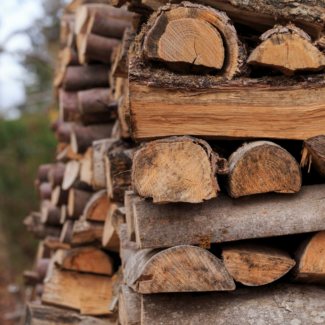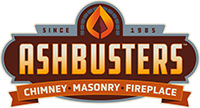If you belong to the community of people who own a wood-burning fireplace, you probably have some established habits – like what and how you burn, where you store logs, and how you care for your system. Let’s revisit those habits and see if you’re using your fireplace for all it’s worth and getting as much benefit from your fireplace as possible,
What to Keep Out
To begin, let’s make clear what shouldn’t be making its way into your fireplace.
🔥 Trash
 Trash – even trash like paper and cardboard – does not belong in your fireplace or stove. There is such a thing as too much heat for your fireplace, and these super dry materials will generate more heat than you want. Their light, thin construction also makes them apt to float up your chimney where they can cause a fire in your chimney or on your roof.
Trash – even trash like paper and cardboard – does not belong in your fireplace or stove. There is such a thing as too much heat for your fireplace, and these super dry materials will generate more heat than you want. Their light, thin construction also makes them apt to float up your chimney where they can cause a fire in your chimney or on your roof.
Keep in mind what you learned in high school chemistry – all matter, including that greasy pizza box or old newspaper – is composed of chemicals. Burning the wrong types of matter can release toxic chemicals into the air you breathe. This is the case with many items you might be tempted to toss in your fireplace. If you aren’t confident that a particular item is safe to burn – don’t burn it!
🔥 Styrofoam & Plastic
Styrofoam and plastic are also culprits when it comes to releasing toxic chemicals. Not only are these harmful for health (which is a primary concern), but they also release black smoke that can damage your home and furniture.
🔥 Treated Wood
Some things you shouldn’t burn may be a little surprising. For instance, not all wood is good for burning in a fireplace. Construction straps – think treated wood, plywood, painted scraps, 2x4s, and particle board – can release toxic compounds such as arsenic and burn dangerously hot.
🔥 Accelerants
Speaking of dangerous burns, never use accelerants in your fireplace, even if it’s just to get your fire going. These are difficult to control, and the resulting blaze can be damaging to your chimney and fireplace.
What You Can Burn in Your Fireplace
The only thing that should be burned in a wood-burning appliance is… wood! But not all woods are equal. As we noted, treated wood and most wood products are unsuitable for a home fireplace. Also unsuitable is damp or green wood. The only fuel source you should be using in your stove or fireplace is well-seasoned firewood.
The only fuel source you should be using in your stove or fireplace is well-seasoned firewood.
When newly cut, wood logs have a high moisture content. By the time you burn it, the moisture content should be down 15-25 percent. What happens in the meantime? Time and careful storage, mostly! Proper storage allows air to circulate, evaporating off water, but also protects wood from elements like snow and rain that can make it soggy, musty, and unfit to burn over time.
When wood contains too much moisture, the resulting fire will smolder. Not only does this mean it will give you less of the heat and clear, lively flames you desire, it will also produce more smoke and cooler flue gases. Cooler flue gases and excessive smoke may not vent well, creating respiratory hazards and causing dangerous gases to linger in your living space.
Smoldering is also known to cause a greater accumulation of combustible creosote and soot in your chimney flue, increasing the risk of a chimney fire. In short, you want the moisture content of your logs to be right so your fire will burn hotter, safer, and cleaner.
Should Certain Wood Varieties Be Avoided?
 You may have heard the rumor that hardwoods are preferable to softwoods. While different wood species do have their pros and cons, which you should use is simply a matter of what best suits your needs.
You may have heard the rumor that hardwoods are preferable to softwoods. While different wood species do have their pros and cons, which you should use is simply a matter of what best suits your needs.
Softwoods, such as cedar, spruce, and pine, are lighter, and they also tend to have more sap – so handle them with care! Hardwoods, such as oak, hickory, walnut, maple, and most fruit trees, are more dense than softwoods.
The density of a wood variety is a significant variable in the heat output you’ll get from burning it. In other words, your softer woods will generate less heat by volume than hardwoods, but will be easier to light and get going. Hardwoods may take more effort to start, but will give you a sustained, roaring blaze.
Either category of wood, when appropriately seasoned, is suitable for your fireplace. If you have an abundant supply of both, you can think strategically – saving your softwoods for the milder days at the beginning and end of the heating season, and using it for kindling year-round.
One more thing to keep in mind – firewood is normally sold by volume, so you can expect to fairly pay more for hardwoods, which will last longer and generate more heat per volume.
Seasoning & Storing Firewood
There are many suppliers who will deliver straight to your property, but if you’re more of a DIY type and have access to choppable wood, you might consider cutting your own. Either way, you’ll want to make sure it’s seasoned before you burn it.
Firewood will reach and maintain proper seasoning better when:
- Cut to shorter lengths and split to increase surface area
- Chopped 6-12 months before use
- Stored off the ground
- Covered on top to avoid sustained contact with rain or snow
- Uncovered on the edges to allow access to sun and circulating air
When your logs have lost much of their initial weight, sound hollow when knocked together, and appear aged (with cracks, splits, and darkened edges), it’s probably ready to use. A more reliable way to check is by purchasing a moisture meter and looking for a reading between 15 and 25 percent.
Book Inspections With Us for Optimum Efficiency
Of course, burning only the proper fuel doesn’t guarantee your system is ready to go. It’s merely one component in keeping a properly efficient running system. That said, when you couple this with annual inspections, regular chimney cleanings, and swift repairs (when needed) from your friendly, neighborhood chimney experts, you’ll be ready to use your fireplace optimally all season.
Let’s get started – call us (615) 510-7323 or reach out online now to set up your appointment
